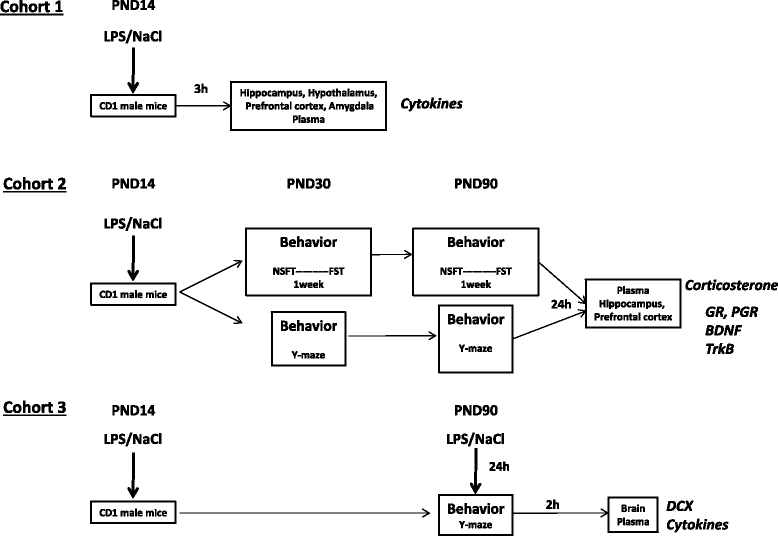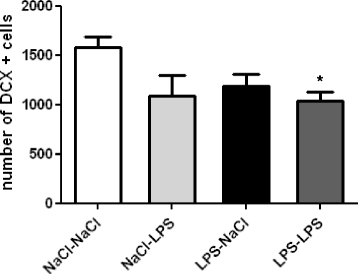Inflammation early in life is a vulnerability factor for emotional behavior at adolescence and for lipopolysaccharide-induced spatial memory and neurogenesis alteration at adulthood
- PMID: 25224537
- PMCID: PMC4172903
- DOI: 10.1186/s12974-014-0155-x
Inflammation early in life is a vulnerability factor for emotional behavior at adolescence and for lipopolysaccharide-induced spatial memory and neurogenesis alteration at adulthood
Abstract
Background: The postnatal period is a critical time window during which inflammatory events have significant and enduring effects on the brain, and as a consequence, induce alterations of emotional behavior and/or cognition later in life. However, the long-term effect of neonatal inflammation on behavior during adolescence, a sensitive period for the development of neurodevelopmental psychiatric disorders, has been little studied. In this study, we examined whether an early-life inflammatory challenge could alter emotional behaviors and spatial memory at adolescence and adulthood and whether stress axis activity, inflammatory response and neurogenesis were affected.
Methods: Lipopolysaccharide (LPS, 100 μg/kg) was administered to mice on postnatal day (PND) 14 and cytokine expression was measured in the plasma and in brain structures 3 hours later. Anxiety-like and depressive-like behavior (measured in the novelty-suppressed feeding test and the forced swim test, respectively) and spatial memory (Y-maze test) were measured at adolescence (PND30) and adulthood (PND90). Hypothalamic-pituitary-adrenal (HPA) axis activity (plasma corticosterone and glucocorticoid receptors in the hippocampus and prefrontal cortex) was measured at adulthood. In addition, the impact of a novel adult LPS challenge (100 μ/kg) was measured on spatial memory (Y-maze test), neurogenesis (doublecortin-positive cell numbers in the hippocampus) and plasma cytokine expression.
Results: First, we show in PND14 pups that a peripheral administration of LPS induced the expression of pro- and anti-inflammatory cytokines in the plasma and brain structures that were studied 3 hours after administration. Anxiety-like behavior was altered in adolescent, but not in adult, mice, whereas depressive-like behavior was spared at adolescence and increased at adulthood. This was accompanied by a decreased phosphorylation of the glucocorticoid receptor in the prefrontal cortex, with no effect on corticosterone levels. Second, neonatal LPS treatment had no effect on spatial memory in adolescence and adulthood. However, a second challenge of LPS in adulthood impaired spatial memory performance and neurogenesis and increased circulating levels of CCL2.
Conclusions: Our study shows for the first time, in mice, that a peripheral LPS treatment at PND14 differentially alters emotional behaviors, but not spatial memory, at adolescence and adulthood. The behavioral effect of LPS at PND14 could be attributed to HPA axis deregulation and neurogenesis impairment.
Figures







Similar articles
-
Enriched dairy fat matrix diet prevents early life lipopolysaccharide-induced spatial memory impairment at adulthood.Prostaglandins Leukot Essent Fatty Acids. 2016 Oct;113:9-18. doi: 10.1016/j.plefa.2016.08.013. Epub 2016 Aug 24. Prostaglandins Leukot Essent Fatty Acids. 2016. PMID: 27720041
-
Periodic maternal separation decreases hippocampal neurogenesis without affecting basal corticosterone during the stress hyporesponsive period, but alters HPA axis and coping behavior in adulthood.Psychoneuroendocrinology. 2012 Mar;37(3):410-20. doi: 10.1016/j.psyneuen.2011.07.011. Epub 2011 Aug 20. Psychoneuroendocrinology. 2012. PMID: 21862224
-
Developmental minocycline treatment reverses the effects of neonatal immune activation on anxiety- and depression-like behaviors, hippocampal inflammation, and HPA axis activity in adult mice.Brain Res Bull. 2016 Jan;120:1-13. doi: 10.1016/j.brainresbull.2015.10.009. Epub 2015 Oct 28. Brain Res Bull. 2016. PMID: 26521068
-
Investigations of HPA function and the enduring consequences of stressors in adolescence in animal models.Brain Cogn. 2010 Feb;72(1):73-85. doi: 10.1016/j.bandc.2009.06.003. Epub 2009 Jul 17. Brain Cogn. 2010. PMID: 19616355 Review.
-
The protective role of the hypothalamic-pituitary-adrenal axis against lethality produced by immune, infectious, and inflammatory stress.Ann N Y Acad Sci. 1995 Dec 29;771:419-37. doi: 10.1111/j.1749-6632.1995.tb44699.x. Ann N Y Acad Sci. 1995. PMID: 8597419 Review.
Cited by
-
Microglial Priming and Alzheimer's Disease: A Possible Role for (Early) Immune Challenges and Epigenetics?Front Hum Neurosci. 2016 Aug 9;10:398. doi: 10.3389/fnhum.2016.00398. eCollection 2016. Front Hum Neurosci. 2016. PMID: 27555812 Free PMC article. Review.
-
The acute effects of antimicrobials and lipopolysaccharide on the cellular mechanisms associated with neurodegeneration in pubertal male and female CD1 mice.Brain Behav Immun Health. 2022 Oct 28;26:100543. doi: 10.1016/j.bbih.2022.100543. eCollection 2022 Dec. Brain Behav Immun Health. 2022. PMID: 36345322 Free PMC article.
-
Neonatal Immune Challenge with Lipopolysaccharide Triggers Long-lasting Sex- and Age-related Behavioral and Immune/Neurotrophic Alterations in Mice: Relevance to Autism Spectrum Disorders.Mol Neurobiol. 2018 May;55(5):3775-3788. doi: 10.1007/s12035-017-0616-1. Epub 2017 May 23. Mol Neurobiol. 2018. PMID: 28536974
-
Dexmedetomidine exerts an anti-inflammatory effect via α2 adrenoceptors to alleviate cognitive dysfunction in 5xFAD mice.Front Aging Neurosci. 2022 Sep 20;14:978768. doi: 10.3389/fnagi.2022.978768. eCollection 2022. Front Aging Neurosci. 2022. PMID: 36204551 Free PMC article.
-
Chronic Supplementation with a Mix of Salvia officinalis and Salvia lavandulaefolia Improves Morris Water Maze Learning in Normal Adult C57Bl/6J Mice.Nutrients. 2020 Jun 15;12(6):1777. doi: 10.3390/nu12061777. Nutrients. 2020. PMID: 32549250 Free PMC article.
References
-
- Karrow NA. Activation of the hypothalamic-pituitary-adrenal axis and autonomic nervous system during inflammation and altered programming of the neuroendocrine-immune axis during fetal and neonatal development: lessons learned from the model inflammagen, lipopolysaccharide. Brain Behav Immun. 2006;20:144–158. doi: 10.1016/j.bbi.2005.05.003. - DOI - PubMed
Publication types
MeSH terms
Substances
LinkOut - more resources
Full Text Sources
Other Literature Sources
Research Materials

